“Death in Slow Motion” / “The Riddler’s False Notion”
Written by Dick Carr
Directed by Charles R. Rondeau
Season 1, Episodes 31 and 32
Production code 8731
Original air dates: April 27 and 28, 1966
The Bat-signal: A silent film festival at a fancy new cinema in Gotham comes to an end. As the crowd gathers in the lobby, the head of the festival thanks Mr. Van Jones, who lent the festival films from his private collection of silent pictures.
They’re interrupted by a Charlie Chaplin impersonator and a woman in a red dress who do an entire act, complete with three guys playing the Keystone Cops who chase “Chaplin” around. At one point, the Chaplin impersonator takes refuge in the box office, where he gasses the ticket taker, steals the receipts, then comes out and finishes the show, with no one the wiser.
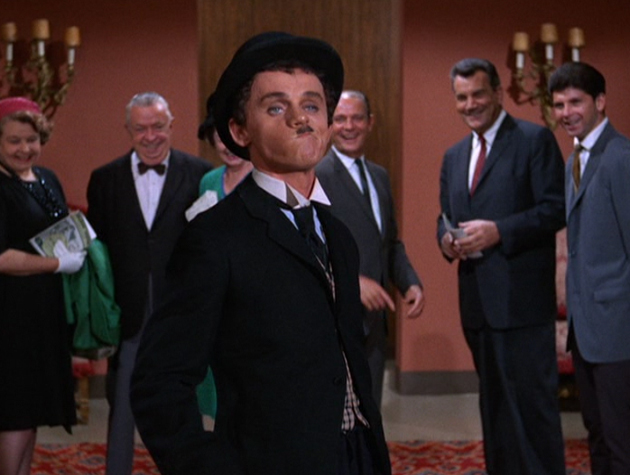
The festival organizer assumes that Van Jones arranged this, but instead the old man is outraged that a bunch of amateur performers stole his thunder. The party breaks up, and the organizer goes to the box office, only to find the ticket taker unconscious, the money gone, and a riddle left behind: Why is a musician’s bandstand like an oven?
It is, in fact, the Riddler who was playing Chaplin, and upon realizing he’s back in business, Gordon immediately calls Batman. O’Hara, for his part, is baffled as to why the Riddler even bothered, as he only got about $200.
Robin figures out the riddle, as it depends on musician’s slang term “bread” for money: a bandstand is like an oven, because it’s where he makes his bread. That leads them—of course—to Mother Gotham’s Bakery.
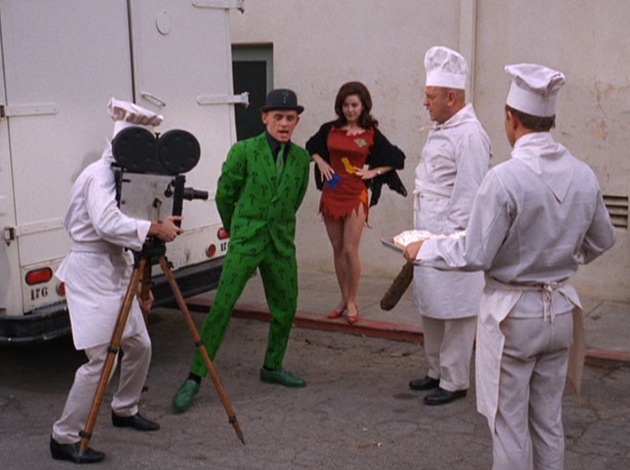
Riddler is already there with his moll Pauline, the one in the red dress—now dressed in what’s supposed to be rags—and the three henchmen. Riddler reveals that they’ve been hired by Van Jones to make a new silent film, which is also a cover for his true criminal master plan. The theft of the bakery’s payroll is also, like the theft of the box office receipts, a petty crime to draw the Dynamic Duo so Riddler can film them.
Pauline starts crying crocodile tears and goes into the kitchen, begging for bread to feed her poor starving mother. She offers her tattered shawl as payment—then she tosses it over the baker’s head and then a henchman biffs him with a loaf of French bread. They go to the payroll office, where Riddler hits the guard with a pie made with whipped sleeping cream and nuts. The same pies are then used on the two accountants, and then he uses an explosive éclair to blow the safe open. They steal the payroll and then Ridder leaves a note for Batman and Robin with cake icing.
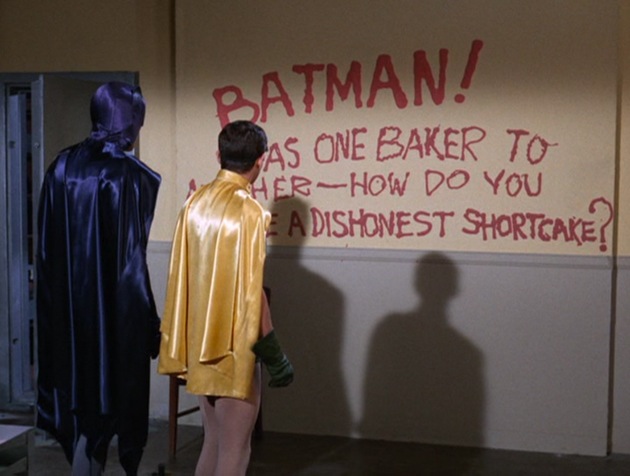
The Dynamic Duo arrive to find four unconscious employees, a blown safe, and a note on the wall: “Batman! As one baker to another—how do you make a dishonest shortcake?” The answer is with a lie-berry, a corruption of library, and there’s a Gotham City Library branch on Baker Street. They head there to see a van parked in a no-parking zone—however, the van has diplomatic plates, so Batman and Robin leave them alone. (Turns out it’s the Ridder’s van, and he’s continuing to film everything.)
Unfortunately, the Baker Street branch is closed on Wednesdays due to lack of funds. However, the lock has been tampered with, so they break and enter (they’re good guys, they can do that) and as soon as they enter, they’re clubbed on the head with a giant copy of A Pictorial History of Silent Films by Y.Y. Flurch.
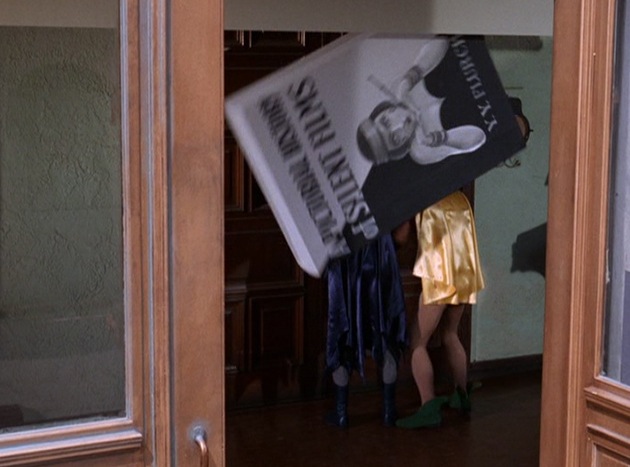
Riddler heads out, while the Dynamic Duo open the weighty tome, which has two more riddles on the flyleaf: What do you find in a kitchen cabinet that is not alive? When is a new car considered to be seedy? They take the big book back to the Batcave.
In his hideout in an abandoned film studio, Riddler screens a rough cut of his film (which manages to have jump cuts and multiple angles despite having only one camera, and most of the angles are from where the camera never actually was).
In the Batcave, the Dynamic Duo and Alfred work on the riddles. Alfred points out that everything in a cabinet should not be alive—dead forks, dead knives, dead spoons, dead pots, and dead pans. They decide that the clue is deadpans, like the expressions on silent film stars, and that this will be a deadpan simple crime. Uh, sure.
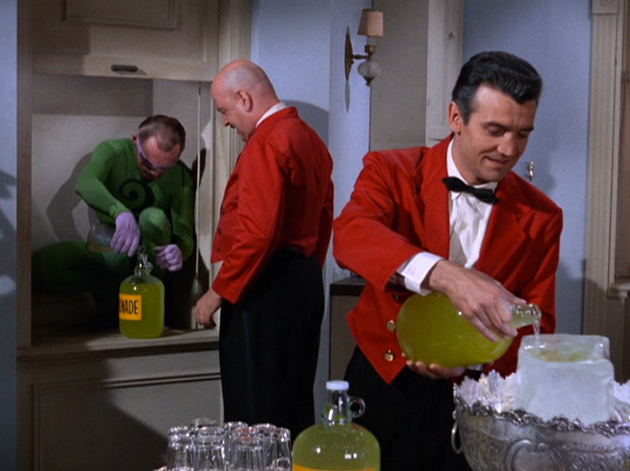
They turn to the second riddle: a new car is seedy when it’s a lemon. Batman knows that Van Jones is a noted temperance advocate, and is holding a “cocktail” party in which the only drink that will be served is lemonade. But Riddler is spiking the lemonade.
The first effects of the spiked lemonade can be seen when O’Hara and Gordon get into an argument about baseball players. When Batman enters, he accidentally bumps a woman, who mouths off at him. It quickly becomes clear to Batman that everyone’s in a bad mood.
As if to prove it, the woman Batman bumped into socks another woman in the jaw, and a big fight breaks out. Batman’s response to this outbreak of violence is to—stand around and watch? Er, okay.
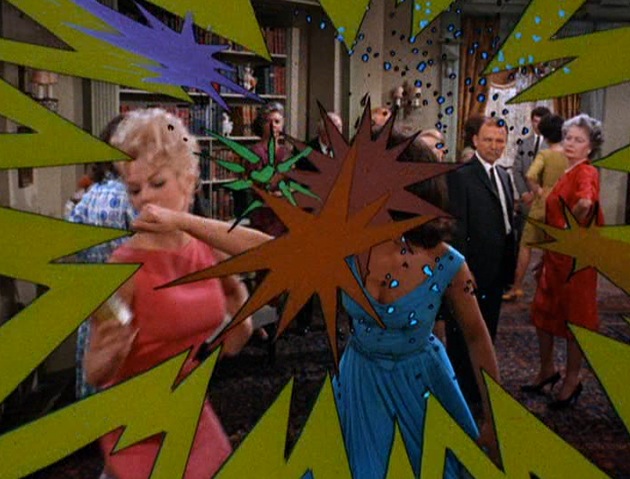
Outside, Robin is in the Batmobile, when he’s approached by Pauline, who’s dressed as Bo-Peep, complete with a giant crook. (Ahem.) Robin comments not at all on what she’s wearing (then again, look at what he’s wearing), and she says a man in green tights jumped her brother and kidnapped him, and also asked a question while performing this felony: when is a bonnet not a bonnet? The answer is, apparently, when it becomes a woman (er, um—what?), and she congratulates him on getting it before gassing him with the crook.
Inside, Batman finally decides to take action. He stands with his hands raised in the air and yells for everyone to stop. Amazingly, this doesn’t work at all. However, he sees Riddler’s goons filming the festivities. The goons shoot at Batman and run away. Batman radios Robin, but he’s already been captured.
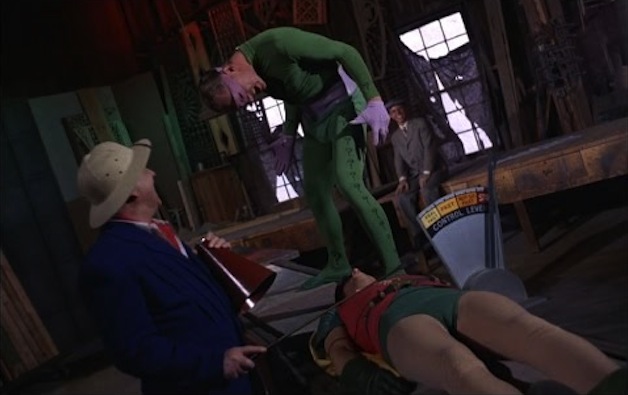
We cut to Riddler’s hideout, where Robin is tied to a conveyer that sends him head-first toward a buzz saw, a trap right out of a silent melodrama. Riddler turns on the conveyer—using a control lever whose settings are “stop,” “not so fast,” “fast,” and “real fast”—to the highest setting and giggles madly. (The conveyer is moving at about one mile every five weeks on “real fast,” so I shudder to think how slow “fast” would be on that thing…)
After giving Gordon (and presumably the other partygoers) a universal antidote pill, Batman runs out of Van Jones’s mansion to find Robin’s radio, but no Robin. He’s joined by an apologetic Gordon, and after Batman takes the time to rebuke Gordon for not being careful with regards to whom he takes free lemonade from, they’re confronted with two new Riddler clues: Why is a bear like a fallen tree? Why is silk like grass? The first is lumber (a bear lumbers, a fallen tree becomes lumber), the second is a yard (how both are measured), and Batman speeds to the Gotham lumberyard.
Batman searches the lumberyard for Robin, but only finds Riddler, dressed in a top hat, cape, and big-ass mustache. Oh, and a whip, which he uses to keep Batman from using his batarang. But before Batman can engage in fisticuffs, Riddler draws his attention to Robin on the conveyer belt. Quickly, Batman dashes to the buzzsaw—but it turns out to be a mannequin. At some point, after filming Robin on the conveyer belt, he switched the Boy Wonder out with a dummy.
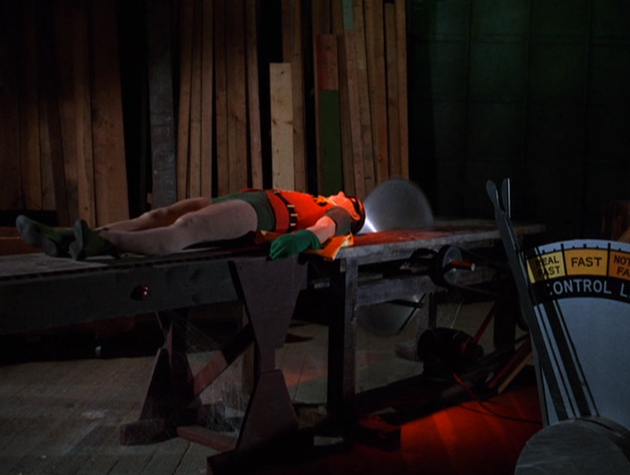
Riddler and his camera man escape, but Batman manages to capture Pauline and bring her to police headquarters. However, Pauline is only willing to give her first name and the name of her lawyer. Batman offers to work on her in the Batcave, and asks Gordon to come along as well, as he’d like a witness to make sure he doesn’t do anything that would bounce back on him in court. (Of course, she asked for her lawyer, which under Escobedo v. Illinois, she’s entitled to. Not having her lawyer present during the interrogation after she asked for him will bounce back in court. So probably would kidnapping her and taking her to an undisclosed location, but we’ll let that go…)
Gordon is like a kid in a candy store when Batman wakes him up and shows him the Batcave. When they wake Pauline up, they both speak in slow, stentorian tones, probably in an endeavor to intimidate her. They test the truth of her answers by the quality of the air she breathes into a mask (just go with it). Pauline says she doesn’t know where Robin is, but she does know two riddle clues: Why is Flo Ziegfeld like a near-sighted man? (They both put on spectacles.) What kind of men are always above board? (Chessmen.)
Batman tests the mask, and she’s telling the truth. He gasses her and Gordon again and off they go. Given the silent-movie theme of the Riddler’s caper, he assumes the spectacles are a reference to Harold Lloyd, who wore spectacles and always had cliffhangers. There’s also a building in Gotham called the Chessman Building.
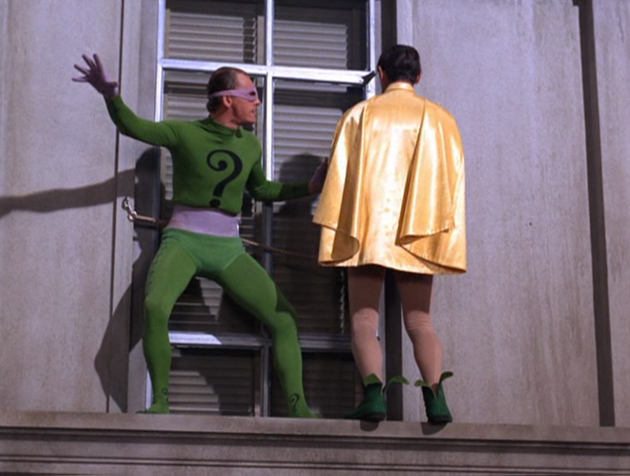
After dropping Gordon and Pauline off on a street corner for O’Hara to pick them up, Batman heads to the Chessman Building, where Robin is standing on a narrow ledge. Riddler pushes him off—but Batman throws down the Bat-rope, and Robin catches the batarang on the end with his teeth. Batman then pulls Robin up by the teeth to the roof, causing the Dynamic Duo to briefly expound on the wonders of good dental hygiene.
Riddler escapes in a helicopter, and skywrites two more riddles: What kind of machine has ears? (A train—it has engine-ears, er, rather, engineers.) Why does a cowboy wear a tight belt? (To hold up his pants, duh.) Robin deduces that Riddler plans to hold up the El Chief train, which is a famous train that movie people used to take. The Dynamic Duo head to Gotham Central Station, and alert the police to head there too, to guard El Chief.
But Riddler is across town at Van Jones’s place, dressed as a cowboy, and handing over the final print of Riddler’s silent film of Batman and Robin, the only one of its kind. Van Jones hired Riddler to create this film for a hundred thousand dollars. Van Jones loves the film, despite the lack of a soundtrack, and opens the safe to put the film in with his other collectibles. As soon as Van Jones opens the safe, Riddler pulls a gun on him and clean out the vault of all the films.
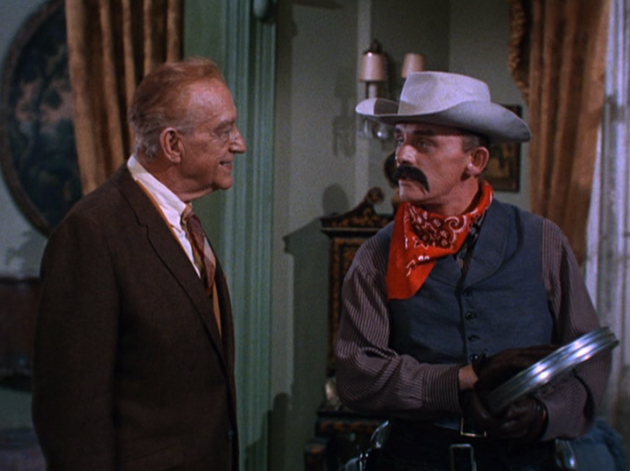
But then the Dynamic Duo shows up. They figured out the double meaning of the clues in the skywriting: The Great Train Holdup, a classic silent movie that Van Jones has the only remaining print of.
Fisticuffs ensue, and Batman and Robin are triumphant.
They get home in time for Aunt Harriet’s birthday, where they provide a surprise for her: Batman and Robin show up to wish her a happy birthday and kiss her on the cheek. Harriet is overwhelmed, and wonder if Bruce and Dick (who are meeting her at the restaurant) will ever believe it. (Har har.)
Fetch the Bat-shark-repellant! Batman has a bat-key that can apparently open any lock. Handy, that. He also uses bat-gas to render Gordon and Pauline unconscious while taking them to and from the Batcave. Once there, he uses the Truth Control Bat-Tester—an oxygen mask with a Batman logo on it—to interrogate Pauline. When Riddler escapes in a helicopter, Batman laments that they don’t have the Bat-copter with them—said item will actually be seen in the film.
While he doesn’t use it, there is a machine in the Batcave labelled “Bat-Terror Control.” I don’t even…
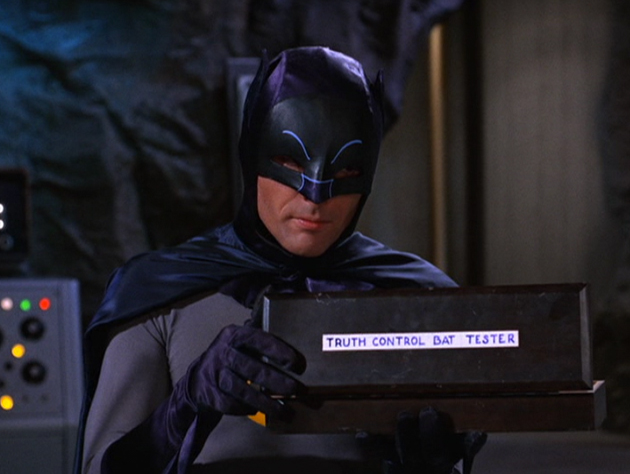
Holy #@!%$, Batman! Dick inexplicably says, “Holy triple feature” when Bruce informs him the Riddler is back, even though he has no idea yet that his newest crime spree is movie related. After being bashed on the head by the giant book, Robin mutters, “holy headache.” After being pulled up by the mouth, he says, “holy molars, I sure am glad I take good care of my teeth.” When the Riddler skywrites clues, Robin pulls out the old standby, “holy smoke!”
Gotham City’s finest. Gordon’s man-crush on Batman is on overdrive in “The Riddler’s False Notion,” particularly the way he geebles over the Batcave. (For some inexplicable reason, he never actually asks why Batman doesn’t, say, donate, or at least loan, some or all this useful crime-fighting equipment to the police department.)
Special Guest Villain. Back for his fourth appearance of the year, making him the most prolific villain in the season (there’s only one two-parter left after this), is Frank Gorshin as the Riddler. This is his last appearance on the series until the third season’s “Ring Around the Riddler.” Gorshin will appear in the Batman film between seasons, but his Emmy nomination for the role led to a contract dispute that wouldn’t be resolved for a year. As a result, the character only appeared once in season 2, played by John Astin.
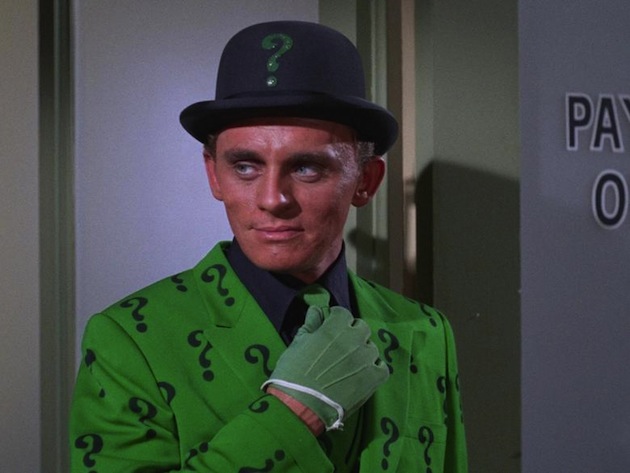
No sex, please, we’re superheroes. Director Charles R. Rondeau makes sure to emphasize Sherry Jackson’s body as much as possible, including lots of shots that emphasize her legs and her bust. As a heterosexual male, I’m not complaining overmuch, but even by this show’s standards, it was pretty unsubtle.
Na-na na-na na-na na-na na.
“These are special pies—whipped sleeping cream and nuts.”
“Whipped sleeping cream and nuts?”
“Nuts to you!”
–Riddler’s repartee upon giving the payroll guard a pie in the face.
Trivial matters: This episode was discussed on The Batcave Podcast episode 16 by host John S. Drew with special guest chum Robert Greenberger, former DC Comics editor and author of (among many other things) The Essential Batman Encyclopedia.
This story was inspired by the comic book story “The Joker’s Comedy Caper” in Detective Comics #341 (published only a year earlier) by John Broome & Carmine Infantino. Frank Gorshin’s lengthy career doing impersonations is probably part of why the role of person-who-disguises-himself-as-Charlie-Chaplin-to-commit-a-robbery was switched to the Riddler instead of the Joker, as in the comic.
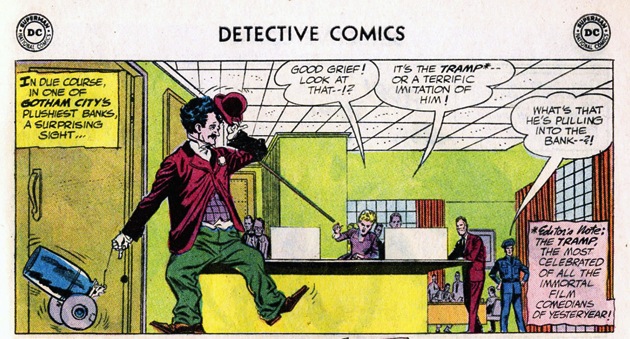
Van Jones is played by Francis X. Bushman, who was actually a major silent film star. One of his many starring roles was in The Grip of the Yukon, for which his co-star was Neil Hamilton. This was one of Bushman’s last roles before his death in August 1966.
Pauline is played by Sherry Jackson, who would appear later this calendar year as Andrea, the sexy android in “What Are Little Girls Made Of?” on Star Trek, in an outfit that was even more revealing than anything she wore in this two-parter, which is saying something. Her character’s name is a play on The Perils of Pauline silent movie serial.
The Great Train Holdup is a play on the classic film The Great Train Robbery. Pauline’s lawyer is Oliver Wendell, a play on Oliver Wendell Holmes Jr., who served on the Supreme Court from 1902-1932.
Overt references are made to silent film stars Charlie Chaplin (Riddler’s impersonation) and Harold Lloyd (the method of Robin’s “cliffhanger”), as well as impresario Flo Ziegfeld, who put on “The Ziegfeld Follies” revue.
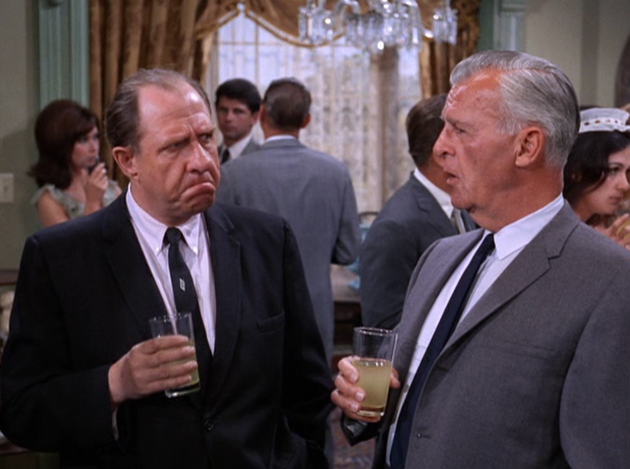
Gordon and O’Hara argue over whether or not Maury Wills, who was the shortstop for the Los Angeles Dodgers at the time the show was airing, was better than Honus Wagner, who was the Hall of Fame shortstop for the Pittsburgh Pirates from 1900-1917 and was generally considered one of the three or four best shortstops in baseball history. To be blunt, the notion that Wills was better than Wagner is hilariously absurd, as Wagner was one of the best all-around players of his era, and Wills was a decent shortstop who happened to steal a lot of bases. Gordon’s declaration that O’Hara was an oaf was accurate under the circumstances…
Gordon mentions that people have been known to enter the Batcave and never come out, which is probably a reference to a previous moll of the Riddler’s, Molly in “Smack in the Middle,” whom Batman also brought to the Batcave to interrogate, but who died when she fell into the atomic pile.
Pow! Biff! Zowie! “Rolling, Riddler baby!” This is one of those episodes of Batman that dances on the edge between hilarious and ridiculous, and I can’t make up my mind whether or not I like it.
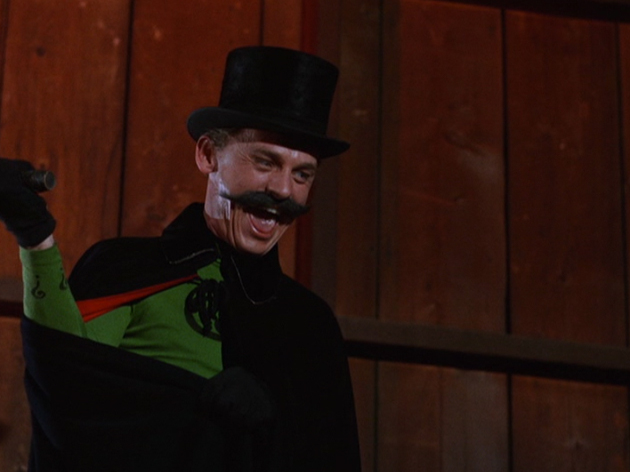
Part of that is because there’s really only one reason why this episode exists: it’s here to showcase Frank Gorshin’s comedic talent. By this time, they realized what gold they had in Gorshin’s abilities, and this episode is specifically designed to make use of his talents as an impressionist. His Charlie Chaplin at the top of “Death in Slow Motion” is particularly entertaining.
But beyond that, the script is kind of a mess. They do a classic silent-movie cliffhanger with Robin on the buzzsaw conveyer, but then blow it with the resolution by having it be a dummy. (Why????) The Riddler revealing that Van Jones is financing the movie early in “Death in Slow Motion” takes the wind out of the sails of the story, spoiling what could have been a very effective twist when Riddler delivers the film to Van Jones in “The Riddler’s False Notion.” And even by this show’s standards of ridiculous rescues, having Robin catch the batarang in his teeth to stop his fall—when he’s just fallen off a ledge and is accelerating at 9.8 meters per second squared toward the ground—just cuts off the air supply to my disbelief.
Then there’s the hilarious cognitive dissonance of Batman refusing to allow Pauline to talk to her lawyer, as is her legal right—and in case we forget it’s her legal right, O’Hara reminds us that it is—so he can conduct an interrogation of her in the Batcave, but insists on Gordon coming along so nothing will blow back on him in court. Yeah, good luck with that.
Having said all that, every Riddler episode Gorshin appears in is worth watching because Gorshin’s in it, even if this one is a lot more self-indulgent than the others.
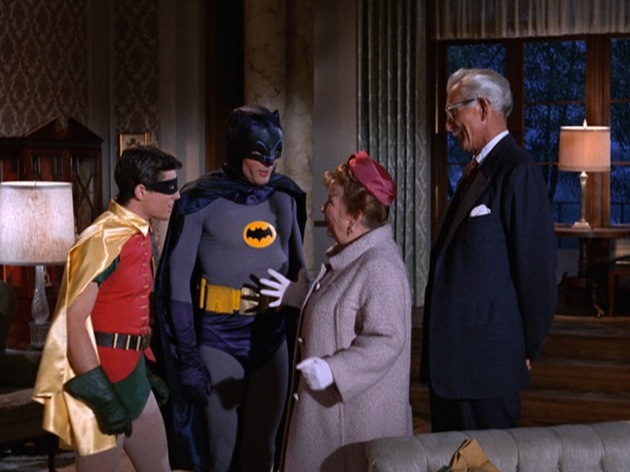
One amusing thing: the lengthy Charlie Chaplin/Keystone Kops opener meant that they had to trim the sequence where Gordon activates the Bat-phone, Alfred finds Bruce and Dick, they lie to Aunt Harriet, they talk to Gordon, they slide down the poles, they get into the car, they drive off, the car goes down the road, and they pull in front of GCPD HQ and run upstairs. In this case, Bruce and Dick are already in the library so they answer the phone themselves, the conversation with Gordon is truncated, and they cut straight from driving past the “GOTHAM CITY 14 MILES” sign to their arrival at police HQ. It actually shows how much that sequence is, well, redundant filler, and I was perfectly happy to lose all that unnecessary nonsense so I could watch Gorshin do Chaplin.
Bat-rating: 5
Keith R.A. DeCandido‘s latest work of fiction is “Streets of Fire” in the anthology V-Wars: Night Terrors, the third volume in the shared-world vampire series created and edited by Jonathan Maberry and published in print by IDW and audio by Blackstone.










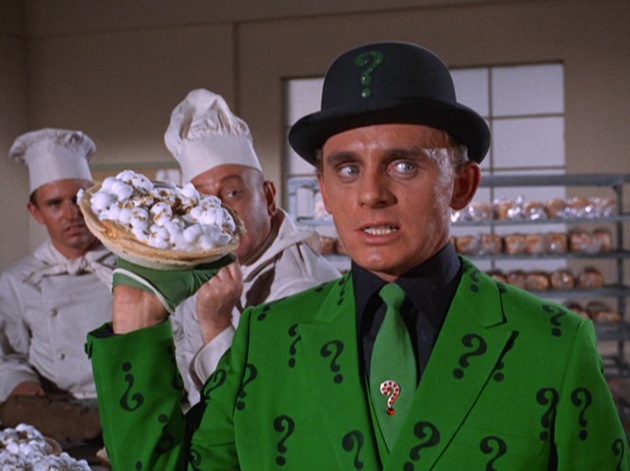
It’s a ok episode. For me, a little Frank Gorshin goes a long way. And, no giant cookbook…
The pun in “a bonnet is not a bonnet when it becomes a woman” is that you can read “the bonnet becomes a woman” as “the bonnet looks good on a woman”. It’s not a very good pun, but it’s there.
“The answer is, apparently, when it becomes a woman (er, um—what?),”
“That bonnet becomes you,” as in “that bonnet looks good on you.” :P
Edit: And beaten by like a minute, haha.
The pun in “a bonnet is not a bonnet when it becomes a woman” is that you can read “the bonnet becomes a woman” as “the bonnet looks good on a woman”. Not that it’s a very good pun.
The Riddler was certainly the most prolific criminal in season 1, with four appearances vs. three each for the Penguin and Joker, and only one each for everyone else, even Catwoman. (I’d say Robin’s “Holy triple feature” might be in reference to the Riddler’s frequent returns, but it would have to be a quadruple feature.) And once again, they’re giving him a theme of the week in addition to riddles, this time silent films. Which, as Keith says, was no doubt done to take advantage of Frank Gorshin’s impressionist skills. Anyway, it’s a clever caper, and actually rather coherent on the Riddler’s part, for a change. There’s the usual progression of zany set pieces, but they serve a purpose as “scenes” in the film the Riddler is shooting as a con to get into Van Jones’s vault.
Although it has some weird beats along the way. “Sleeping cream?” What the hell is that? “Temper tonic” is weird too — though it led to the first-ever civilian Bat-fight, if you can call it that. And the whole cliffhanger thing with the Robin dummy always seemed weird to me. Well, it seemed weird to me as an adult. I remember being pretty creeped out by it when I was younger, when I thought it was actually Robin being sawed.
Oh, Commissioner Gordon. You’re such a groupie.


 Hmm, I think Pauline is another unrepentant moll. The girls in this town are getting tougher.
Hmm, I think Pauline is another unrepentant moll. The girls in this town are getting tougher.
And ohhhhhh my gods, Sherry Jackson. Those legs…
Keith, the opening sequence wasn’t entirely redundant, because the convention in TV shows at the time was to air the act-one credits over dialogue-free sequences — since it was assumed then that people would actually read them, I guess, in contrast to today where they just flash small credits in the corner where they can be easily ignored. So they needed a long enough dialogue-free sequence to accommodate the credits — just like all the second parts opened with Batman and Robin struggling wordlessly against the deathtrap while the credits rolled and not beginning to talk until after the director’s credit had faded.
And the others are right — it’s “becomes a woman” in the sense of “flatters” or “suits,” as in the song “Moonlight Becomes You” or the Zemeckis movie Death Becomes Her. See also “becoming” as a synonym for “attractive.”
Y’know, I was gonna edit my post to fix the “becomes a woman” joke, but the pun was so abstruse and bad, that I’m standing by what I said. Goodness knows, there are enough comments explaining it…………
—Keith R.A. DeCandido
Given access to a Batcave and Sherry Jackson, I understand wanting to take her there and work her over….
If a villain took off today the way Gorshin’s Riddler did in 66, he’d have his own spin-off by the time the fall season started. It’s a wonder Gorshin never got his own variety show.
After you noted that Pauline is the same actress as Andrea (such a creative name), I pondered the strong connections between this show and Star Trek. Thinking about it, I realized that it’s really more a sign of what a small talent pool television still had in the mid-60s. As a medium, television was still a bit of a red-headed stepchild, and a lot of actors didn’t want a lot to do with it, fearing it would harm their career. That’s why you so often see the same actor playing several different guest roles on a show over a few seasons.
The Miranda decision wouldn’t be handed down until a couple of months after this episode aired. Obviously, Batman and Gordon thought they could get away with.
And Robin catching the batarang with his teeth clearly reflects his circus training.
@8/DemetriosX: It’s just as common today for the same actors to show up all over the TV dial. Not that long ago, Summer Glau was popping up everywhere. More recently, Bridget Regan has been turning up on multiple different shows. And there are dozens of actors who are constantly popping up in anything filmed in Vancouver or Toronto — Roger Cross, Mike Dopud, Hiro Kanagawa, Venus Terzo, Christopher Gauthier, etc.
Sure, in the Canadian case, a talent pool of limited size is a factor. But to a large extent, it’s simply that actors who do good work, who are popular with audiences and directors and producers, who are reliable and get along well with their colleagues, tend to get more job offers.
I don’t think this show ever acknowledged Dick Grayson’s past as a circus performer. In fact, one thing that’s struck me on my recent rewatch is that, while the show was strikingly faithful to the comics of the ’50s and early ’60s in most respects, it totally changed the portrayal of Dick/Robin. In the comics, and in his guest appearances on the Superman radio series (where he was marvelously played by Ronald Liss), Robin was basically an antecedent to Spider-Man — a nonstop wisecracker, a preteen swashbuckler constantly dropping quips and one-liners and bad puns as he took on the bad guys with a cocky smile. He was the identification figure for the young readers, so he was charming and fun and charismatic. But Burt Ward’s Robin is the most serious character on the show besides Commissioner Gordon. He’s defined by his earnest intensity. His wordplay is limited strictly to his “Holy…” interjections — which are original to the show, as far as I know, and are delivered with too much shock or distress to seem like jokes on the character’s part — and to his proclivity for deciphering riddles and clues. If anything, in the spectrum of boy sidekicks, he’s closer to Jimmy Olsen than to the comics’ Robin.
But I can see why they would’ve wanted a more serious Robin. After all, the basis of the comedy was that the characters themselves were not in on the joke — they took everything with deadpan ultra-seriousness, while only we, the viewers, could see how absurd their behavior and circumstances were. Having one of the heroes be a constant jokester and wisecracker himself would’ve been too self-aware and wouldn’t have fit the style of the show’s humor. (Then again, Airplane! had Johnny, the one character who was in on the joke and openly being silly. But he was a background character, not the second lead.)
@8: The problem is that Batman and Gordon didn’t fail to follow Miranda v. Arizona (which requires the suspect to be informed of their right to an attorney), but Escobedo v. Illinois from 1964 (which stated that suspects have the right to have their attorney present during interrogation).
I believe the episode deserves credit for one thing above all else: for once, the villain had an actual reason to provide the Dynamic Duo with clues to his next acts. That made me grind me teeth on a regular basis (as did the inability to just kill the two when they fell for the traps set for them).
I love batman especially for the car. How about this car for the next?
Torvald_Nom: Thank you for correcting my research fail there. Will edit the post forthwith….
—Keith R.A. DeCandido
How do you skywrite with a helicopter?
@13/lordm: You tell me what “temper tonic” is, and I’ll tell you how to skywrite with a helicopter.
Well, “temper tonic” is probably just alcohol — which, come to think of it, might answer your question too. :D
Well, obviously. That answers it! :)
My favorite is that Riddler is holding a hose perfectly straight the entire time he’s skywriting, which means the helicopter has to move in the motion of the letters, which has to make everyone in the copter nauseous……
—Keith R.A. DeCandido
That is another great explanation.
This is my favorite Riddler episode; it narrowly wins out over the pilot because of the silent film theme of the Riddler’s crimes and the fact that it has certain elements that hadn’t been developed yet in the pilot (like the themed and costumed henchmen). The one thing I would have changed: cutting out that conversation where Riddler exposits to his henchmen that he’s been hired to make a movie by Mr. Van Jones. A great twist ruined for no good reason.
The fact that this is an adaptation of a Joker comic (which I have read; it’s in the ’90s-era printing of “The Greatest Joker Stories Ever Told,” along with the story that inspired “The Joker Is Wild”/”Batman Is Riled”) makes me wonder: what would it have been like if Frank Gorshin had been cast as the Joker instead of Cesar Romero?
@18/Craverguy: As I’ve mentioned before (although I’m repeating an insight I heard from others), Mark Hamill’s Joker is essentially based on Gorshin’s Riddler. So we already kind of know what a Gorshin Joker would be like.